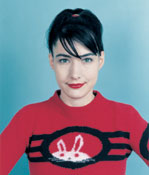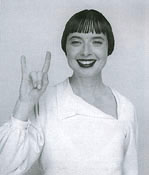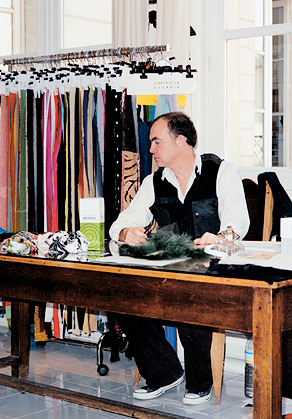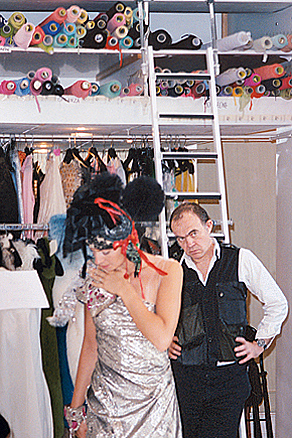 |
  |
 |
  |
 |
 |
| |

Read Bjork's2001 interview with Juergen Teller from the index archives. |

|
 |

Kathleen Hanna discusses writing and making music in this interview from 2000 with Laurie Weeks. |
|
 |
|
 |
|
|
 |

Isabella Rossellini spoke with Peter Halley in this 1999 interview. |
|
 |
|
|
 |
 |
|
Alexander McQueen's 2003 interview with Bjork. |
|
 |
|
|
 |
|

|
| Christian Lacroix,2003
WITH MICHEL GAUBERT
PHOTOGRAPHED BY PIERRE BAILLY |

|
Christian Lacroix recounts to Michel Gaubert his journey from Arles, through Paris's revolutionary moment, to the return of Cocteau in the neo-Baroque '80s glory of the priviledge club.
Growing up in Arles, did you get to London or Paris much?
CHRISTIAN: When I went to London in the early '60s I bought pseudo-erotic black-and-white images by Aubrey Beardsley. I read Oscar Wilde. In 1967, I met a super-sexy girl in Arles, who wore silver sandals and enormous gypsy blouses. She knew all about Gustave Moreau and Beardsley. She was the daughter of a radical hairdresser named Bobby, who was also the director of a movie club, where we saw films like Polly Maggoo and Mr. Freedom. One night she invited us to a very bourgeois house. The inside was straight out of the film fin de siecle, with gas lamps. Everyone wore period outfits and women walked around holding English parasols like during the Belle Epoque. There was a woman wearing a red peignoir named Marie Colette. I recognized her from seeing her at the band, the Credit Agricole. [laughs]
MICHEL: Sounds a bit like Bette Davis as Baby Jane.
CHRISTIAN: Sort of. But Marie Colette was only twenty-five. She received you from her bed, lace galore, holding her lamp. I arrived with a notebook in hand. I drew. I wasn't allowed to speak. I loved to listen. The ninety-year old grandmother who lived their was always drunk. She'd been a tart in Monte Carlo at the turn of the century. She kept a scimitar and a dagger for all the troublemakers. Marie Colette's mother now has all my drawings from '66 and '67, sketches of people in the house, people straight out of Cocteau — musicians, mediums, bullfighters. No one thought such personalities could exist in Arles. In ten years they'd be gone.
MICHEL: Were people trying to recreate the past in Paris when you first lived there?
CHRISTIAN: I arrived in Paris at a moment when the bourgeoisie had become revolutionaries, giving the past it's honor due. We created a gallery of ancients. In fact, just before the revolution of 1789, fashion was also inspired by history. That was around the time when Herculaneum and Pompeii were discovered. But the look of that time generated modernism, beginning with neo-gothicism of the nineteenth century- Princess Eugenie dressed like Madame de Pompadour. Much later, designers like Dior and Saint Laurent recreated styles form the '30s and '40s. It was a strange but exciting time, one that you were too young to have known.
MICHEL: I remember art deco circa 1970. David Bowie, glitter rock...
CHRISTIAN: A remake of the '30s, as if they'd never existed. That was the idea behind glam clubs like Seven and The New Eve. You could eat and dance to live music. To enter you had to descend a grand staircase.
MICHEL: Glamour's not exactly the word.
CHRISTIAN: Maybe you don't remember the grand Eugene, a drag queen who brought back the elegance of the old caberets, of Edith Piaf and Mistinguett. There were photographs — tres, tres louche — of her weeping deliriously over a drag queen who had been suspiciously murdered right after his singing debut on Champs Elysees. That was in 1971. It was the return of high fashion, of couture... white satin, perfect blonde wigs. The blonde bombshell was back with total elegance. Eugene's still with Dior.
MICHEL: It's true, Paris of the '30s and '40s was recreated everywhere in France during the '70s. I remember the director of Chanel did everyone up like Marlene Dietrich, Greta Garbo...
CHRISTIAN: Peter O'Toole's wife Sian Phillips dressed up like Marlene Dietrich. She looked like Marlene, wore a huge coat like her. Supposedly around the time of Marlene's last concert, Phillips also sang like heart the Espace Cardin. That's how "Marlene" influenced Cardin. That's when we started looking back to dandyism and fin-de-siŽcle naivetŽ. Going out in Paris was like going out in the '30s dressed like the Andrews Sisters. It was everything I'd seen in books at my grandparents' house, only it was our generation. I'd experienced the '40s and '50s by looking at my grandparents' old clothes, books, and magazines. They created a kind of collage. But it seemed like the more we advanced, the more the future looked impossible, making us return to the more radical times in the past. For me, fashion had emerged from the flea market in Clignancourt, which was inspired by the explosion of British pop. Then Karl Lagerfeld showed us everything.
MICHEL: Everything?
CHRISTIAN: Yes. In 1974, Karl put out such a sublime men's collection I was stunned. I suddenly felt less unique, realizing I wasn't the only one with such taste, because there it was, incarnated by Lagerfeld.
MICHEL: Do you miss those times?
CHRISTIAN: The notion of time bothers me. You look at thirty-year-old photographs and realize how the time has passed. We all look for lost time. I think the '90s were about a return to a period just before it.
MICHEL: Weren't the '80s a mix of art deco and the '40s?
CHRISTIAN: They were the final opulence before a period of crisis. Basquiat and Schnabel, whose paintings we could have seen as caricatures, were normal icons of our times. It was like a return to the age of Cocteau, a neo-baroque born in the avant-garde...in the cubic architecture of Robert Mallet-Stevens's Villa Noailles in Hyeres, in the intellectuals who were a bit baroque and a bit bohemian. It was like the seventeenth and eighteenth centuries and a bit of surrealism, all a bit puffed up.
MICHEL: But that self-confidence was so ostentatious, so assuming. It was why people were called "power dressers" in the '80s, with their padded shoulders and self-assured attitude.
CHRISTIAN: There's always some kind of hidden logic. During this summer's Paris fashion shows, everywhere I looked, I saw neo-Renaissance cloaks a la Port Royal.
MICHEL: A basic structure seemed to dominate?
CHRISTIAN: The sleeves were like those you would see in paintings by Cranach — a bit rigid, a bit aggressive. But you don't know where it's going.
MICHEL: When I was a kid, films often influenced fashion. Now there is more than one tendency in every field. It's no longer said that this winter the color is red. That's finished. In Italy, for example, styles seem to be dictated by industry — unlike in Paris. The market sets the rules for wearing this or that.
CHRISTIAN: Italy is a divided country without a center. In France, Paris is the center. In Italy, the Milanese are well organized but follow bourgeois taste. They adhere to certain codes of elegance, but not to individualism. They're a bit like Austrians, with the taste of the north. They say that the best furniture and clothing design from the '50s and '60s is Scandinavian or Milanese. But the Milanese have made bad choices, bad fashion, and bad jewelry.
MICHEL: The first time I visited Milan I thought it would a really well designed city, but it's not at all. I thought Moscow would be the same. Instead, it was sad.
CHRISTIAN: I like the Mussolini perspectives in Italian architecture, and the furniture from the time of King Victor Emmanuel. The worst is the melancholy one finds in Italian suburbs with their spinach-colored houses in disrepair.
MICHEL: Yeah, little by little you understand that Milan is quite a mess.
CHRISTIAN: That could be said for London, Brussels, or Antwerp. The things that bother me about Italy are the dancehalls, certain hotels, and sometimes people's homes. There's something that makes me ill aesthetically. It's not because the places are poor or ugly — even the most opulent places have their disturbing side. But in Italy, there are often things found only in nightmare, particularly in their bathrooms.
MICHEL: You mean the bathroom fixtures.
CHRISTIAN: Exactly. There's no nuance. The same could be said about their crockery, their colors, their living rooms, their kitchens...the bizarre proportions of Italian cafes.
MICHEL: The way they mix odd pinks and greens?
CHRISTIAN: And those strange designs from the '70s and '80s in blond wood. The English aren't really like that. My first time in England, in the '60s, the interiors were somehow familiar to me, probably because of the books I'd read and the images I'd seen.
MICHEL: I had the same impression. I think it's because I listened to the Stones and Bowie since I was a kid. I know those songs by heart. It was like seeing what those songs were about.
CHRISTIAN: I translated Beatles songs for my English class. Even my parents were fascinated. They were born in '27 and '28, and were kids during the liberation of France. My father was just a worker, but he was fascinated.
MICHEL: There's something futuristic about the Anglo-Saxon consumption of music. In England a record can hit number one in a day. Even their hair...All it takes is two or three singers or one top model to wear a certain hairstyle, and bang! The next day the girls are lining up to get their hair cut that way. In France, even now, we hear something and don't know if it's good or not.
CHRISTIAN: For fifteen years I've had Swiss clients who tell me that it's a mystery how the French react to their own artists, especially the painters. One of them said, "In the '50s, artists like Soulages and Dubuffet were well known, but the French ignored them." He'd bought Dubuffet paintings in the '50s. The French wait for the Beauborg-Pompidou stamp of approval before they buy. The French are like that.
MICHEL: A bit lukewarm.
CHRISTIAN: That's why modernism isn't so strong in France. It's still exotic. Even if we like it, it's not something that we take to viscerally. The French are tempted by things, but we tend to keep a distance. It's what makes French taste more about fascination than passion. The Paris store Colette is successful because it's a filter for things that are made elsewhere. It's the kind of store France needs.
MICHEL: It's also a French thing to say that modernity is ridiculous. People said that about email, "It's too modern. It'll never work." But it always does.
CHRISTIAN: If I were a teenager, I'd make computer drawings. I need people to do that for me because I don't have the time.
MICHEL: Some people are afraid of technology. Whether it's a machine or a credit card, they think it's a form of witchcraft.
CHRISTIAN: I've been reading a book on Belgian architecture lately and have been amazed. Brussels in the '50s already looked toward the aesthetic of Blade Runner, and the science fiction that would become the repertoire of the late twentieth century. Bourgeois France is nothing like that, except for a few Mackintosh-like buildings in the north. French design hardly exists, except as artificial modernism.
MICHEL: French design is a bit neo- '20s, with horrible colors and grape vines festooning everything.
CHRISTIAN: The typography here in France is equally catastrophic. Maybe we'll like it in twenty years but I doubt it. In Anglo-Saxon countries, it's more natural. In conservative London the signs above those mahogany and copper pubs never look fake. There isn't as much design as we think. It's the weakness of our times. Radicality works. Remember Rochas building?
MICHEL: Loved it.
CHRISTIAN: For what seemed like forever people thought it was scandalous, because it was more dynamic than just about anything else.
MICHEL: I went there long ago. The cafeteria was fantastic. You entered a room full of wooden furniture and copper lamps, then you opened a door and the hall was painted a varnished purple. There was a disco and a little bar. It's a pity when places like that are destroyed, because they recall the most passionate moments of an era.
CHRISTIAN: No doubt. But it takes an almost arrogant confidence to do something that interesting. There are days when I'm completely depressed and able to do only one drawing. I'm by no means a complainer, but when you feel good you feel confident, and it's easier for me to make something of quality. But in that earlier time there was confidence in the air. We felt it.
MICHEL: I remember when the Privilege club opened in 1980, designed by Gerard Garouste. That was gutsy, especially for a painter to do!
CHRISTIAN: When it first opened, people flipped out.
MICHEL: I was the DJ for the opening. There were cast-iron chairs and couches that were thrown out six months later. People hated them because they were too uncomfortable. The slipcovers had even been torn up. It didn't work at all for the first year.
CHRISTIAN: What was great was the feeling of modernity, in the paintings, the walls, the furniture. It was like the set of a movie from the '70s.
MICHEL: There were other places that I like but that seemed cursed, like Karl Lagerfield's shop, which was a kind of architectural hallucination. The interior was amazing, with it's terrazzo floor and Bohemian colored-glass ceiling. And the exterior!
CHRISTIAN: That's completely gone.
MICHEL: There were also stores that seem almost mythic now.
CHRISTIAN: Le Drugstore was like that.
MICHEL: Yes, at the top of the Champs Elysees. It was a very fashionable store, almost like Colette today.
CHRISTIAN: It's as impossible to bring back the '60s as it is the Belle Epoque of my grandparents. But I hang on to the memory of clothes that no longer exist.
|
|
 |
|
|
 |

©
index magazine
Christian Lacroix by Pierre Bailly, 2003 |
|

©
index magazine
Christian Lacroix by Pierre Bailly, 2003 |
|
 |
|
|
| |
|
 |
 |
|
Copyright © 2008 index Magazine and index Worldwide. All rights reserved.
Site Design: Teddy Blanks. All photos by index photographers: Leeta Harding,
Richard Kern, David Ortega, Ryan McGinley, Terry Richardson, and Juergen Teller |
| |